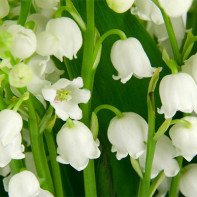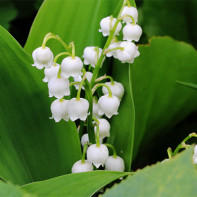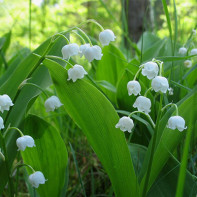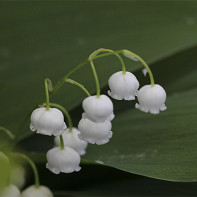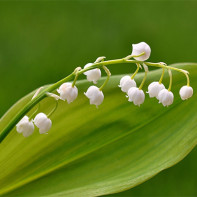Lily of the valley: medicinal properties and contraindications
Lily of the valley is familiar to many. This flower is distinguished by its beauty and unique aroma. It is called one of the symbols of spring due to the fact that the flowering period falls on May. But not everyone knows that it is also used in traditional medicine. With the right approach, it helps to cope with most diseases, but if you handle it carelessly, then everything can end in death.
- Chemical composition
- How it looks and where it grows
- Collection and storage
- The healing properties of lily of the valley
- Lily of the valley in traditional medicine
- With glaucoma
- With neurosis
- With insomnia
- With hypertension
- With epilepsy
- For joint pain
- With heart disease
- Types of healing compounds
- Infusion
- Tincture
- Decoction
- Tea
- Lily of the valley oil: properties and applications
- Application in cosmetology
- Contraindications
- Interesting facts about lily of the valley
Preparations based on this plant have been used in medicine since the end of the twentieth century. They are used to treat cardiovascular diseases. For example, they are administered intravenously in heart failure. Once inside, the medicine slows down the rhythm of the heart, reduces shortness of breath, etc.
Chemical composition

Lily of the valley belongs to plants that are used not only in traditional medicine, but also in traditional. The reason is its composition. Laboratory studies have shown that it contains essential oils that give the plant that very unique smell, polysaccharides, flavonoids and malic acid. It also found glycosides (convallatoxin and convalloside) and alkaloids. In addition, it contains starch, citric acid and various coumarins.
Thanks to such an impressive list of elements, lily of the valley is successfully used to treat certain diseases, especially the heart.
How it looks and where it grows
This is one of the most famous and beautiful flowers. The plant has 2-3 leaves, the base of which is located almost at the roots. The leaves have a dark green color and an oblong shape. On the main stem of the plant, which is located between the leaves, there are bell flowers. Their number can vary from 5 to 20 pieces. The plant itself is low and rarely reaches even 30 cm. The flowers are distinguished by a special characteristic aroma, which is a symbol of spring for many.
The flowering period is short, usually 2-3 weeks. Lower flowers begin to bloom before the rest. The beginning of flowering occurs in different latitudes at different times, depending on air temperature.
Fruits also appear on lilies of the valley. They have a red color and a diameter of up to 9 mm. Inside the fruit is hollow, has three chambers, each of which contains seeds. By the onset of summer, berries usually have time to form. They make up the diet of some birds, despite the toxicity of the plant as a whole for humans and animals.
This flower is not very whimsical. It can adapt to different conditions and grows even in Siberia, but it is mainly found in places with a temperate climate, throughout Europe, on the mountain slopes of Asia and in the northern part of America. In the natural habitat, this flower grows in forests, often found on the fringes of coniferous, deciduous and mixed forests. It can also be found in meadows, mountainsides and near rivers. Uncontrolled collection led to the fact that the plant was listed in the Red Book.
Collection and storage
For medicinal purposes, you need to go for raw materials in May-June. It is during this period that flowers bloom, which are most often used for treatment. After the beginning of flowering, the highest amount of biologically active substances is observed in them. Leaves can be harvested 15–20 days before flowering begins.
To avoid the death of the plant, you need to cut the raw material with a knife 2-3 cm from the ground. It is better to dry on the day of collection, because if the raw materials wither, glycosides will break down and the healing properties will be weaker.
Since lily of the valley is listed in the Red Book, certain rules must be followed when collecting plants.The first and most important thing is that it is allowed to collect raw materials at the same place no more than once every three years. Also, flowers need to be harvested in limited quantities. In order not to disturb the ecosystem, a distance between cut plants of 70–100 cm should be maintained.
It is also important to remember that the collection of medicinal raw materials should be done only in sunny weather. It would be ideal if a few days before the collection a little rain fell. Also, do not collect plants that grow along the tracks and in the city.
It is best to use dryers with forced ventilation. In the process of harvesting raw materials, it is necessary to maintain a temperature of 55-60 degrees inside the dryer. You can spread the raw materials in a heated room, but then you have to open the windows so that there is access to air. You will also need to mix the raw materials from time to time.
As soon as the leaves and petioles become brittle, it means that the raw materials have dried sufficiently. The smell of a dried plant is much weaker than that of a fresh one, but it tastes bitter. The healing properties of the plant are preserved for two years in paper bags. It can also be stored in wooden cases if lined with white paper.
The healing properties of lily of the valley
Lily of the valley leaves have a calming effect when taken orally. For external use, they are able to heal wounds faster. From the leaves of this flower, preparations are made for the treatment of neurosis, problems with the heart and blood vessels, as well as the thyroid gland. The substances contained in the leaves of the plant are able to treat some eye diseases and epilepsy. Infusion of lily of the valley leaves has a restorative effect, increases the tone of the body and protects it from viruses and bacteria.
Lily of the valley flowers relieve headaches and strengthen the nervous system. They are even used to treat paralysis. Very often, powder from lily of the valley flowers is inhaled. This method of application helps to cure a cold or migraine. Often it is used in herbal medicine, where the flower often becomes a component of various fees.
Lily of the valley in traditional medicine
In folk medicine, lily of the valley is often used as an anti-inflammatory and diuretic. It increases the amount of excreted salts from the body. It is also used to treat diseases of the throat and heart, especially tachycardia.

In England, lily of the valley is used to strengthen the immune system and prevent viral diseases. Infusions and decoctions are drunk for headaches and disorders of the nervous system.
With glaucoma
To treat this disease, an infusion of lily of the valley and nettle leaves is used. It will take 1 teaspoon of lily of the valley leaves and a third of a glass of nettle leaves. Grind herbs thoroughly, then mix and pour a glass of boiled water. Cover the glass and put in a dark place for 9 hours. Then add 1/2 tsp of soda to the infusion. Mix the mixture thoroughly and apply to the eyes twice a day. The effectiveness of the product will be much higher if the raw materials collected in May are used for treatment.
With neurosis
Use this prescription is only after consulting a doctor. For the treatment of neurosis and maintaining the heart in a healthy condition with defects, use tincture of lily of the valley flowers. The glass bottle must be filled with 1/3 of the flowers. Then pour 95–97% alcohol into the bottle. Cork the bottle tightly and place in a dark place. Insist for 14 days by shaking the mixture once a week. At the outlet, the liquid should be transparent, with a yellowish tinge. It has a bitter taste, but a pleasant aroma. Drink three times a day for 10 drops of tincture, diluted 1 tbsp. a spoonful of water after eating.
With insomnia
Many people suffer from this ailment. There are many reasons for the development of insomnia, but most often it is provoked by stress, problems at work or an unfavorable environmental environment. For a long time, the infusion of lily of the valley flowers has been taken to improve sleep. It will take 1 tbsp. spoon of dried lily of the valley flowers. Pour it in a glass of boiling water and leave to infuse for 10 hours in a thermos. Take 1-2 tbsp. tablespoons thrice a day.
With hypertension
In order to lower blood pressure, use tincture. Since doing it for quite some time, it is advisable to stock up on medicine in advance. You need to count 25-30 dried flowers, then crush them and mix in a glass container with one glass of vodka. Close the container tightly and put in a dark place for a week.
As soon as the tincture is ready, strain it thoroughly, then drink once a day 15 drops, previously diluted with water. Take the medicine until the pressure is normal, however, it is recommended to take breaks from time to time, since this is a dangerous remedy.
With epilepsy
For the treatment of epilepsy, use tincture on wine. To prepare it, you need to take a small amount of fresh flowers of lily of the valley (20-30), then rinse them thoroughly and dry them by spreading them on a soft towel for 30-40 minutes. Next, grind the flowers with a wooden pestle.
Mix flowers with wine in a glass bottle in a proportion of 1:10. Next, add honey to the wine. For 0.5 l of tincture, 3 tbsp. tablespoons of honey. You can also add 1–2 tbsp additionally to this volume of tincture. tablespoons chopped lemon balm. Close the tincture tightly with a lid and put in a dark place for 2 weeks.
Take the finished medicine three times a day for 1 teaspoon.
For joint pain
Joint pain is often pestering older people. Often young people suffer from them, but alcohol tinctures can relieve inflammation and pain in a short time. Tincture is also able to relieve swelling. To prepare, you need fresh flowers of lily of the valley, they need to be crushed and grated, then mixed with vodka in a ratio of 1:10. Close the lid tightly and put in a dark place for 2 weeks.
To treat joints, tincture is applied externally. A soft tissue is required, it must be folded 4 times, then soaked in tincture. Apply to a sore spot for 1-2 hours. It is recommended to additionally tie the lotion with a soft woolen cloth. It is advisable to put lotion twice a day - morning and evening.
Also, a good result is shown by grinding with tincture of lily of the valley. Every 8 hours, you need to rub the sore spot, and then wrap it with a warm cloth.
With heart disease
Traditional medicine has long used a tincture of lily of the valley for the treatment of heart disease. Most often, tincture is made from a collection, which additionally includes other herbs. However, it should be remembered that there are a number of restrictions on the intake of this plant associated with heart disease. For example, in case of problems with the myocardium, tincture from lily of the valley is strictly prohibited. Therefore, you can drink it only with the permission of a doctor.
To prepare the collection, which will become the basis of the tincture, you will need:
- fresh flowers of lily of the valley;
- dried hawthorn inflorescences;
- motherwort;
- wild carrot seeds.
Mix the plants in a ratio of 2: 2: 1: 1. For example, 50 g of lily of the valley flowers will require the same amount of hawthorn inflorescences and 25 g of motherwort with carrot seeds. Grind the ingredients thoroughly and mix. Pour the mixture into a glass container and mix with vodka in a ratio of 1: 5. Close the lid tightly and put in a dark place for 14 days.
As soon as the tincture is ready, carefully filter it. To do this, you can use a doubled gauze. Take 15–20 drops, diluted with water, 2-3 times a day.
Types of healing compounds
When preparing any medicine, it is important to remember that this is a dangerous plant. Lily of the valley does not forgive amateur performances, since it is a poisonous plant. You do not need to prescribe treatment yourself, before use, you should definitely consult a doctor. If the doctor permits the use of medicines based on lily of the valley, in no case should the dosage be violated.

Infusion
Infusion is a very effective remedy. In addition, it is simple to cook and does not need to withstand for weeks. Usually, from 1 to 8 hours of infusion is sufficient until the drug is completely ready. The infusion is used to treat insomnia and heart problems. It can also help with hypertension, eye disease.The infusion has a diuretic and anti-inflammatory effect, it is often used to treat diseases of the genitourinary system.
To prepare the infusion, 1 tbsp. a spoonful of dried leaves or flowers of a plant. Pour raw material with boiling water and leave in a thermos for 9-10 hours. The finished product is filtered and consumed in 2 tbsp. spoons per day.
There is a faster recipe for making an infusion. It will take 1 teaspoon of lily of the valley flowers, you need to fill it with a glass of boiling water and insist 30-40 minutes. Ready to use 1 dessert spoon three times a day.
Tincture
Tincture is considered one of the most effective medicines based on lily of the valley. It is recommended for use in diseases of the gastrointestinal tract, tachycardia, heart failure, paralysis, and problems with the genitourinary system. In the old days, healers very much appreciated the lily of the valley tincture for its properties. They mixed raw materials with alcohol in a proportion of 1:10, made tinctures based on collection with lily of the valley. In addition to this flower, the collection included valerian, motherwort or lemon balm. These herbs are also beneficial for the body and complement each other perfectly. Collecting herbs is much more effective than one plant and allows you to additionally treat insomnia, atherosclerosis, and thyroid diseases.
It is not difficult to prepare a tincture for alcohol. It will only require raw materials, a glass container and alcohol. To fill a half-liter jar with fresh flowers of lily of the valley for a third. Then pour alcohol into the jar to the very edge. Depending on the strength of the alcohol, a more or less concentrated starting material will be obtained. In some cases, pure alcohol from 90% may be required, but the classic recipe involves the use of alcohol with a strength of 65–70%. Close the jar tightly with a lid, and then place it in a dark place for 2 weeks. Shake the jar at least once every 7 days. Take the finished medicine no more than 3 times a day for 10-15 drops, which must be diluted with a third glass of water.
Decoction
Decoctions are often used as lotions for rheumatism or glaucoma, however, unlike infusions and tinctures, they are used less often. The compress can relieve pain, and in the case of glaucoma, it can lower the pressure inside the eye. Broth is also an effective remedy for headaches. It is used as an antiviral drug and for menopause.
Decoctions of leaves or flowers of lily of the valley have a pronounced diuretic effect, so they are often used to treat kidneys and diseases of the genitourinary system.
To prepare a decoction, you need to take 15 g of dried leaves of lily of the valley. Pour a glass of boiling water, then cook in a water bath for another 15-20 minutes. Drink the drug for 2 teaspoons 2-3 times a day.
Also, the broth can be prepared from the flowers of the plant. It will take 15 g of dried flowers to pour a glass of a little hot water, and then put in the water bath for half an hour. Next, remove the broth from the heat, cool and strain. Drink 2 tbsp. spoons twice a day.
Tea
Lily of the valley tea is an excellent firming and relaxing remedy. It helps fight insomnia and soothes the nervous system. It is recommended for depression. In addition, tea is useful for the cardiovascular system, adding other herbs to it, you can strengthen the immune system before the upcoming cold.
To make tea, you need only 3-4 flowers per 200 ml of liquid. Brew tea directly in a cup, pour boiling water. Insist it for about 10 minutes, then get the flowers. Next, put sugar to taste and drink instead of regular tea. Despite the small dosage, it is not recommended that they completely replace ordinary tea. 1-2 cups will be enough per day. It is especially effective to drink such tea before bedtime, it can help to fall asleep faster. You can further increase its effectiveness by adding lemon balm or a slice of lemon, which will help strengthen immunity.
Lily of the valley oil: properties and applications
Lily of the valley oil is obtained by distilling flowers and leaves with water and steam. It is almost colorless, but has a faint yellow hue, and the consistency is liquid, the viscosity is practically absent. The finished product has a pronounced aroma of lily of the valley flowers, it also contains shades of the smell of green grass.It has a tonic and nourishing effect, has a rejuvenating effect. Lily of the valley oil moisturizes dry skin and has a beneficial effect on a person’s emotional background.
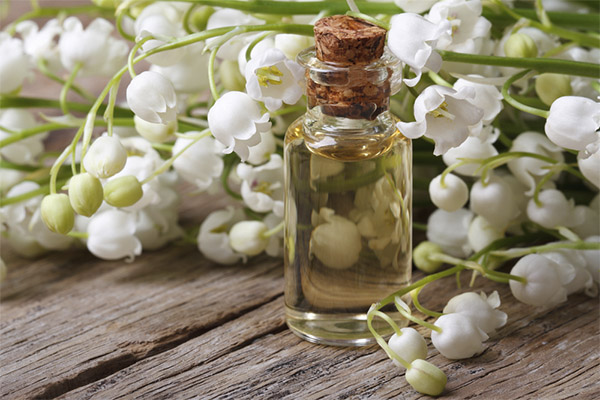
The main industries using lily of the valley oil are perfumes and cosmetology. It is often part of the most popular floral scents. Its aroma is especially harmonious with a rose or jasmine.
In cosmetology, it is used for skin care. Oil can not only moisturize and tone the skin, but also improve its regeneration properties. Lily of the valley oil returns the skin its natural color, helps to eliminate wrinkles. It is also used to combat age spots and pustular skin lesions caused by microorganisms. Oil is able to accelerate wound healing, it is often used for dermatitis and other skin diseases, it relieves the inflammatory process. Often, lily of the valley oil becomes a component of anti-aging therapy.
In conventional medicine, it is practically not used. But it can help people with severe headaches or muscle pain. To this end, lily of the valley oil is used externally, it helps to dilate blood vessels, thereby reducing the intensity of pain.
Lily of the valley oil is also used in aromatherapy because of its tonic effect. It helps to relax a person, relieves anxiety and stress. The aroma is able to increase a person’s mental abilities and increase physical stamina. Oil has a beneficial effect on the human nervous system, allows you to fight insomnia. Very often, the aroma of ether is used for meditation.
In addition, lily of the valley oil is used for massage. It promotes muscle relaxation, improves blood circulation, helps relieve muscle pain.
Lily of the valley oil can only be used for external use. Ingestion even in small doses can lead to severe intoxication of the body, and in some cases to death.
Application in cosmetology
In cosmetology, lily of the valley oil is used very often. At home, its use is less common, since it will not work out on its own. However, you can find ready-made raw materials, but you need to use it carefully. Too high a concentration of lily of the valley essential oil can leave burns on the skin. Also, some people are allergic to this product, and its use can lead to sad consequences.
Lily of the valley oil is an integral part of many skin care products. For example, it is added to hand cream. But you can add oil to your cosmetic accessories yourself. The recommended dose is 4–5 drops at a time. It can be added to shampoo, hand cream or face. For too thick hair, it is allowed to add up to 7 drops of essential oil.
A mask for face and hair can be made from essential oil. To prepare it, you will need 1 egg yolk, 1 tbsp. a spoonful of honey and 2 drops of oil. Mix the ingredients thoroughly, and then apply to the face and hair. Keep the mask for no more than 25 minutes.
You can make an excellent facial toner with essential oil. It is necessary to mix green tea, chamomile and sage in equal proportions, pour boiling water over them, insist a little, then take 30 ml of the infusion, add no more than 2 drops of essential oil and 1-2 tbsp. tablespoons aloe juice. The composition is very carefully applied to clean face skin at night, and in the morning rinse with slightly warm water.
A regular lily of the valley decoction can also be used for hair. However, you need to handle it carefully. Diluted with broth, you need to rinse your hair after washing your hair. This can restore lost volume, as well as strengthen the roots.
Contraindications
The use of lily of the valley should be forgotten by people suffering from problems with the myocardium.Also, it should not be used by pregnant women, nursing mothers and children. They are forbidden to use lily of the valley even for external use. It is necessary to abandon the use in exacerbation of chronic diseases, liver pathologies and cardiosclerosis.
In no case should you use lily of the valley with individual intolerance, even as a grind. External use can lead to burns even if the dosage is observed, and internal use can lead to a severe allergic reaction and death.
With proper use of lily of the valley, side effects are not terrible, and if the dosage is exceeded, nausea, vomiting, diarrhea may appear. In some cases, fainting is possible.
Interesting facts about lily of the valley
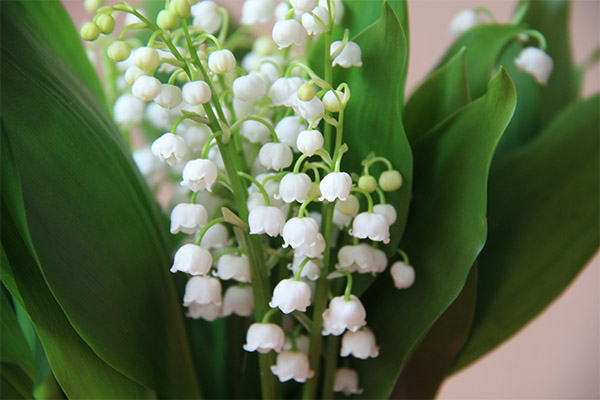
- The benefits of lilies of the valley are undeniable, they are often used not only in traditional medicine, but also in traditional. Due to the intensive collection, their number decreases annually. They were listed in the Red Book as an endangered species.
- In Holland there is a tradition according to which the newlyweds must plant lilies of the valley in their garden after the wedding. The tradition is respected if they have a private garden.
- Lily of the valley is a poisonous plant, however, during the First World War, field doctors used it as an antidote for gas poisoning.
- It is believed that the lily of the valley is a monotypic genus. There is one species of lily of the valley - May, but depending on climatic conditions, new species may appear that develop into separate subspecies. They have practically no differences from May lily of the valley. Mountain lily of the valley is considered one of these species; its only difference from May is slightly enlarged leaves.
- Almost everyone loves the aroma of lily of the valley, it is impossible to confuse this pleasant smell with something. Therefore, it is not surprising that perfumes are also made from this plant. Essential oil is made from it, which gives it such an aroma, then perfume. However, the flower does not contain much essential oil, so manufacturers often synthesize it artificially.
- In Paris, the first Sunday of May is considered the day of the lily of the valley. On this day, the demand for this plant is increasing. They are sent in huge quantities from the provinces to the city, where they distribute the stores. People give these plants to each other, and when the flower dries, they store it in the house. This tradition is rooted in the past, then it was believed that the lily of the valley has magical properties. Today they believe that this flower brings good luck and happiness.
- In the 60s of the last century, Finland declared the lily of the valley its national flower.
- Drops of Zelenin were widely used in medicine. They include tincture of lily of the valley, valerian and belladonna with metol. They are used to treat heart neurosis.
- Copernicus is known to people as an astronomer, but few people know that he was a very skilled doctor. In some ancient portraits he is depicted with a bouquet of lilies of the valley in his hands. Also at one time the lily of the valley was depicted on the emblem of doctors.
- In the old days in France there was a custom according to which a man, inviting a girl to dance, gave her a bouquet of lilies of the valley. If she took a bouquet from his hands, then she agreed not only to dance, but also to begin a romantic relationship. Throwing a bouquet under the donor’s feet was considered an expression of maximum hostility.
- For a person, all parts of a plant are considered poisonous. Moreover, the effect of poisoning can occur even because of the smell, so you can not leave a bouquet of flowers in the room at night. Yes, and in the afternoon it is undesirable to keep the bouquet in the room for too long.
- Wedding bouquets are often made from lily of the valley. This flower symbolizes the purity of the bride and her pure intentions.
«Important: all information on the site is provided exclusively in fact-finding purposes. Before applying any recommendations, consult with a profile specialist. Neither the editors nor the authors are liable for any possible harm caused materials. "

